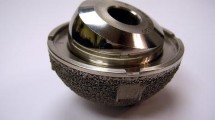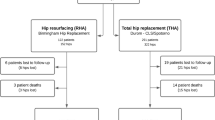Abstract
Background
Despite the many perceived benefits of metal-on-metal (MoM) articulation in total hip arthroplasty (THA), there have been growing concerns about metallosis and adverse reaction to metal debris (ARMD). Analysis of size 36 mm MoM articulation THAs is presented. These patients were evaluated for patient characteristics, relationship between blood metal ions levels and the inclination as well as the version of acetabular component, cumulative survival probability at final followup and functional outcome at final followup.
Materials and Methods
288, size 36 mm MoM THAs implanted in 269 patients at our institution from 2004 to 2010 were included in this retrospective study. These patients were assessed clinically for hip symptoms, perioperative complications and causes of revision arthroplasty were analysed. Biochemically, blood cobalt and chromium metal ions level were recorded and measurements of acetabular inclination and version were examined. Radiological evaluation utilizing Metal Artefact Reduction Sequence (MARS) MRI was undertaken and implant cumulative survivorship was evaluated.
Results
The mean followup was 5 years (range 2–7 years), mean age was 73 years and the mean Oxford hip score was 36.9 (range 5–48). Revision arthroplasty was executed in 20 (7.4%) patients, of which 15 patients underwent single-stage revision THA. The causes of revision arthroplasty were: ARMD changes in 6 (2.2%) patients, infection in 5 (1.9%) patients and aseptic loosening in 5 (1.9%) patients. Three (1.1%) patients had their hips revised for instability, 1 (0.3%) for raised blood metal ions levels. The implant cumulative survival rate, with revision for any reason, was 68.9% at 7 years.
Conclusions
Although medium-sized MoM THA with a 36 mm head has a marginally better survivorship at midterm followup, compared to larger size head MoM articulating THA, our findings nonetheless are still worryingly poor in comparison to what has been quoted in the literature. Furthermore, ARMD-related revision remains the predominant cause of failure in this cohort with medium-sized MoM articulation. No correlation was found between blood metal ions levels and the inclination as well as the version of acetabular component.
Similar content being viewed by others
References
Cohen D. How safe are metal-on-metal hip implants? BMJ 2012;344:e1410.
Quesada MJ, Marker DR, Mont MA. Metal-on-metal hip resurfacing: Advantages and disadvantages. J Arthroplasty 2008;23 7 Suppl:69–73.
Australian Orthopaedic Association National Joint Replacement R. Annual Report/Australian Orthopaedic Association, National Joint Replacement Registry; 2013. Available from: http://www.nla.gov.au/nla.cat-vn2616774. (Date last accessed 15/08/2014)
7th Annual Report England and Wales: National Joint Registry; 2010.
Garellick G, Kärrholm J, Rogmark, C, Herberts, P. The Swedish Hip Arthroplasty Register Annual Report Sweden: The Swedish Hip Arthroplasty Register; 2010.
Langton DJ, Jameson SS, Joyce TJ, Hallab NJ, Natu S, Nargol AV. Early failure of metal-on-metal bearings in hip resurfacing and large-diameter total hip replacement: A consequence of excess wear. J Bone Joint Surg Br 2010;92:38–46.
Ollivere B, Darrah C, Barker T, Nolan J, Porteous MJ. Early clinical failure of the Birmingham metal-on-metal hip resurfacing is associated with metallosis and soft-tissue necrosis. J Bone Joint Surg Br 2009;91:1025–30.
Willert HG, Buchhorn GH, Fayyazi A, Flury R, Windler M, Köster G, et al. Metal-on-metal bearings and hypersensitivity in patients with artificial hip joints. A clinical and histomorphological study. J Bone Joint Surg Am 2005;87:28–36.
Canadian Arthroplasty Society. The Canadian Arthroplasty Society’s experience with hip resurfacing arthroplasty. An analysis of 2773 hips. Bone Joint J 2013;95-B:1045–51.
Ebreo D, Bell PJ, Arshad H, Donell ST, Toms A, Nolan JF. Serial magnetic resonance imaging of metal-on-metal total hip replacements. Follow-up of a cohort of 28 mm Ultima TPS THRs. Bone Joint J 2013;95-B:1035–9.
Agency. MaHpR. Medical Device Alert: All Metal-On-Metal (MoM) Hip Replacements (MDA/2010/033). Medicines and Healthcare Products Regulatory Agency; 2012.
Keegan GM, Learmonth ID, Case CP. Orthopaedic metals and their potential toxicity in the arthroplasty patient: A review of current knowledge and future strategies. J Bone Joint Surg Br 2007;89:567–73.
De Haan R, Pattyn C, Gill HS, Murray DW, Campbell PA, De Smet K. Correlation between inclination of the acetabular component and metal ion levels in metal-on-metal hip resurfacing replacement. J Bone Joint Surg Br 2008;90:1291–7.
Mai MC, Milbrandt JC, Hulsen J, Allan DG. Acetabular cup malalignment after total hip resurfacing arthroplasty: A case for elective revision? Orthopedics 2009;32:853.
Hart AJ, Buddhdev P, Winship P, Faria N, Powell JJ, Skinner JA. Cup inclination angle of greater than 50 degrees increases whole blood concentrations of cobalt and chromium ions after metal-on-metal hip resurfacing. Hip Int 2008;18:212–9.
Hart AJ, Skinner JA, Henckel J, Sampson B, Gordon F. Insufficient acetabular version increases blood metal ion levels after metal-on-metal hip resurfacing. Clin Orthop Relat Res 2011;469:2590–7.
Nicolli A, Bisinella G, Padovani G, Vitella A, Chiara F, Trevisan A. Predictivity and fate of metal ion release from metal-on-metal total hip prostheses. J Arthroplasty 2014;29:1763–7.
Mellon SJ, Grammatopoulos G, Andersen MS, Pandit HG, Gill HS, Murray DW. Optimal acetabular component orientation estimated using edge-loading and impingement risk in patients with metal-on-metal hip resurfacing arthroplasty. J Biomech 2015;48:318–23.
Langton DJ, Jameson SS, Joyce TJ, Gandhi JN, Sidaginamale R, Mereddy P, et al. Accelerating failure rate of the ASR total hip replacement. J Bone Joint Surg Br 2011;93:1011–6.
Smith AJ, Dieppe P, Vernon K, Porter M, Blom AW, National Joint Registry of England and Wales. Failure rates of stemmed metal-on-metal hip replacements: Analysis of data from the National Joint Registry of England and Wales. Lancet 2012;379:1199–204.
Lehil MS, Bozic KJ. Trends in total hip arthroplasty implant utilization in the United States. J Arthroplasty 2014;29:1915–8.
Hosman AH, van der Mei HC, Bulstra SK, Busscher HJ, Neut D. Effects of metal-on-metal wear on the host immune system and infection in hip arthroplasty. Acta Orthop 2010;81:526–34.
Daou S, El Chemaly A, Christofilopoulos P, Bernard L, Hoffmeyer P, Demaurex N. The potential role of cobalt ions released from metal prosthesis on the inhibition of Hv1 proton channels and the decrease in Staphyloccocus epidermidis killing by human neutrophils. Biomaterials 2011;32:1769–77.
Hallab N, Merritt K, Jacobs JJ. Metal sensitivity in patients with orthopaedic implants. J Bone Joint Surg Am 2001;83-A: 428–36.
Martin SF. T lymphocyte-mediated immune responses to chemical haptens and metal ions: Implications for allergic and autoimmune disease. Int Arch Allergy Immunol 2004;134:186–98.
Campbell P, Ebramzadeh E, Nelson S, Takamura K, De Smet K, Amstutz HC. Histological features of pseudotumor-like tissues from metal-on-metal hips. Clin Orthop Relat Res 2010;468:2321–7.
Bolland BJ, Culliford DJ, Langton DJ, Millington JP, Arden NK, Latham JM. High failure rates with a large-diameter hybrid metal-on-metal total hip replacement: Clinical, radiological and retrieval analysis. J Bone Joint Surg Br 2011;93:608–15.
Molli RG, Lombardi AV Jr, Berend KR, Adams JB, Sneller MA. Metal-on-metal vs metal-on-improved polyethylene bearings in total hip arthroplasty. J Arthroplasty 2011;26 6 Suppl: 8–13.
Haddad FS, Thakrar RR, Hart AJ, Skinner JA, Nargol AV, Nolan JF, et al. Metal-on-metal bearings: The evidence so far. J Bone Joint Surg Br 2011;93:572–9.
Glyn-Jones S, Pandit H, Kwon YM, Doll H, Gill HS, Murray DW. Risk factors for inflammatory pseudotumour formation following hip resurfacing. J Bone Joint Surg Br 2009;91:1566–74.
Dawson J, Fitzpatrick R, Carr A, Murray D. Questionnaire on the perceptions of patients about total hip replacement. J Bone Joint Surg Br 1996;78:185–90.
Hosny HA, Srinivasan SC, Keenan J, Fekry H. Midterm results with Birmingham Hip Resurfacing/Synergy stem modular metal-on-metal total hip arthroplasty. Acta Orthop Belg 2013;79:386–91.
Stafford GH, Islam SU, Witt JD. Early to mid-term results of ceramic-on-ceramic total hip replacement: Analysis of bearing-surface-related complications. J Bone Joint Surg Br 2011;93:1017–20.
Author information
Authors and Affiliations
Corresponding author
Rights and permissions
About this article
Cite this article
Akrawi, H., Hossain, F.S., Niculescu, S. et al. Midterm results of 36 mm metal-on-metal total hip arthroplasty. IJOO 50, 256–262 (2016). https://doi.org/10.4103/0019-5413.181786
Published:
Issue Date:
DOI: https://doi.org/10.4103/0019-5413.181786




